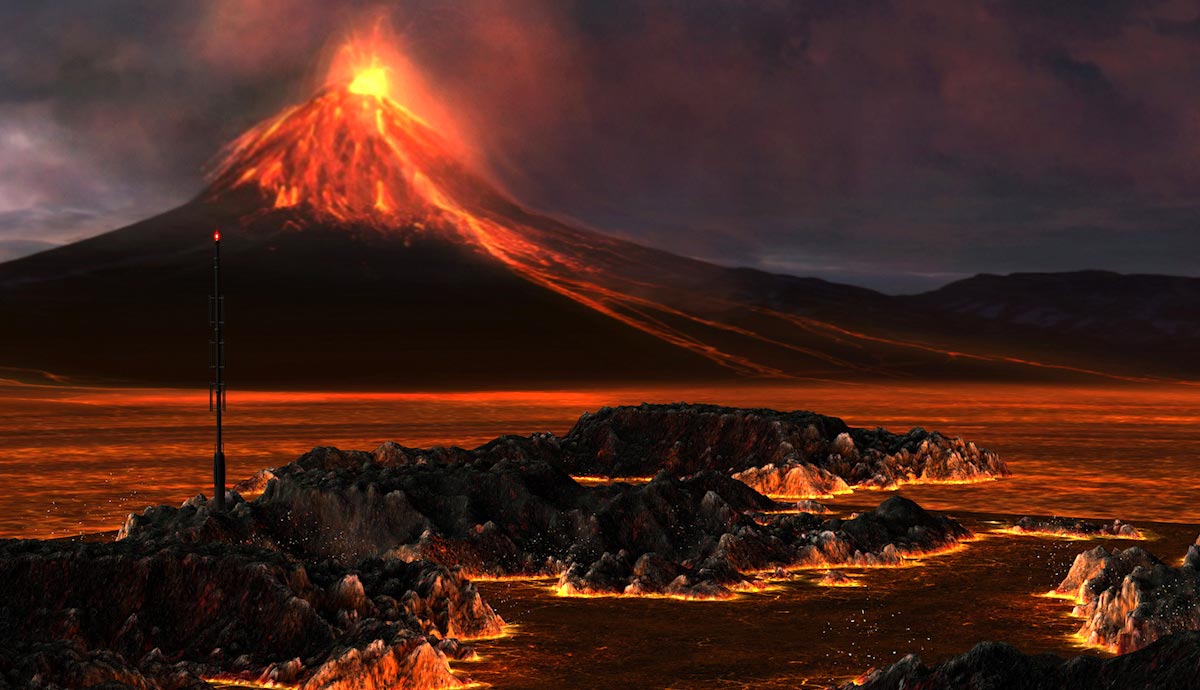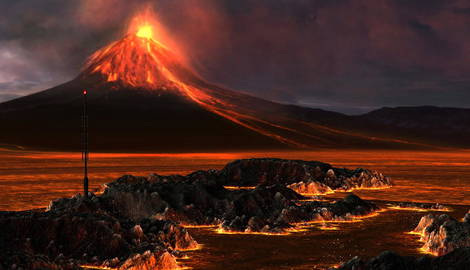
Mount Tambora is a volcano on the Indonesian island of Sumbawa. In 1815, Indonesia was still a part of the Dutch East Indies and was known for its Tambora coffee variety, produced on the slopes of the volcano. When the volcano began erupting on April 5, 1815, the devastation was immediate and widespread. The archipelago of Indonesia and much of the world suffered for around one year due to the massive climatic effect of the eruption. This is the story of Mount Tambora and its aftermath.
The History of Mount Tambora & Sumbawa

Mount Tambora is the highest point on the Indonesian island of Sumbawa. The peak’s volcanic activity is thought to have developed between 57,000 and 43,000 years ago and was formed as such due to the subduction zone that sits beneath the island of Sumbawa.
Before the 1815 eruption, Mount Tambora was thought to have experienced at least three eruption incidents in the current Holocene epoch, in approximately 3910 BCE, 3050 BCE, and 740 CE. The magnitude or length of activity that these eruptions created is unknown to scientists, but the current spree of activity from the volcano began in 1812 and has continued to be active until the present day.
Before the 1815 eruption, Mount Tambora was one of the highest peaks in the Indonesian archipelago, measuring approximately 14,100 feet. However, before 1815, a thriving population of around 10,000 residents was located along the slopes of the volcano. Bronze bowls and fine china of Cambodian or Vietnamese origins were uncovered during excavations, suggesting that the people who lived in the villages along Tambora were wealthy traders.

Despite much of Indonesia being converted to Islam in the 17th century, the remains of the Tambora culture show no such influence, and the extant written material of the Tambora language showed no similarity to the other Austronesian languages of the area. Rather, the Tambora language was thought to have been a language isolated from or distantly related to a Papuan language.
The island of Sumbawa did not play host only to the Tambora culture but also to several principalities and cultures, according to the 14th-century Javanese eulogy known as the Nagarakretagama. Among these were the Bima, Sape, and Dompu people. The island was known for many resources, including sandalwood, sappanwood, honey, horses, and, later, coffee.

Due to its rich natural resources, Subawa has been subject to outside invasion many times throughout its history. The Makassar, Javanese, Balinese, and later the Japanese and the Dutch all invaded the island, which stood as a borderland of sorts between Hindu and Islamic influence in the East Indies.
While the Dutch first arrived on the island in 1605, their influence didn’t take hold until the early 20th century. However, Sumbawa gained independence from the Netherlands as a part of Indonesia in 1945. Today, the island is primarily rural and agricultural, but it has one of the highest GDPs in Indonesia thanks to its copper mine, which is one of the largest in the world. The current population of the island is around 1.6 million people.
Mount Tambora: The Eruption

After several hundred years of dormancy, in 1812, Mount Tambora began to rumble and belch clouds of black smoke. Small eruptions continued for three years until April 5, 1815, when great detonations sounded, and a moderate eruption ensued. The next morning, a rain of ash began falling throughout the island.
Faint explosive sounds continued until April 10, when the volcano erupted in earnest, registering a 7 out of 8 on the Volcanic Explosivity Index (VEI). A plume of gases, rock, and dust shot approximately 24 cubic miles into the atmosphere, and when the column of eruption collapsed, the flow of volcanic material turned lethal.
The pyroclastic flow flew down the sides of Mount Tambora, destroying everything, including the Tambora village and its 10,000 residents. The sound of the eruption was heard over 1,600 miles away on the island of Sumatra, where soldiers thought the sound was that of cannon fire. The resulting rain of ash and other volcanic matter in the area did not let up until April 17.
The eruption is classified as super-colossal and is considered the largest in recorded history, though the eruption of Krakatau in 1883, which was four to ten times smaller than that of Tambora, was more well documented due to the invention of the telegraph. Tambora, having once stood at just over 14,000 feet before the eruption, now reached a maximum height of 9,354 feet.
The Immediate Aftermath

Minor eruptions and aftershocks from the volcano occurred for several months after the initial devastation. In August 1815, British ships reported encountering pumice rafts around 2,600 miles away from the island, while great plumes of smoke and ash remained over the island until August 23.
The main eruption also sent tsunamis flying across the Java Sea to several other islands in the Indonesian archipelago. The death toll of these tsunamis is estimated at 4,600. On the island itself, all vegetation was burned to ash. On Sumbawa, at least 10,000 people were killed instantly by pyroclastic flows, and estimates put the total death toll at at least 70,000 people between Sumbawa and its neighboring islands.
Ash particles were spread almost immediately into far-flung areas of the world, with the optical phenomenon being reported in London, England as early as June 28, 1815. The ash created colorful sunsets and impressive twilight displays for many months following.
While the eruption had caused immediate destruction and loss of life on the island of Sumbawa and its neighboring islands, the worst was yet to come. The sheer amount of ash that stayed in the atmosphere after the eruption would prove to have disastrous consequences, not only in Indonesia but across the globe.
The Year Without a Summer

The eruption is estimated to have released 10 to 120 million tons of sulfur into the stratosphere. This, in turn, was spread over the planet by stratospheric winds, causing an aerosol veil over much of the Northern Hemisphere that was not dispersed by wind or rain for many months.
The eruption and its massive expulsion of ash and gases into the atmosphere caused a global climate anomaly. In addition to the skies turning shades of purple, pink, and red over the following months, the planet cooled at an unnatural speed. Though scientists believe that the eruption of Tambora is not solely responsible for this, the planet was already trending toward cooling. The eruption certainly sped the process along, sending the average temperature in the Northern Hemisphere down by approximately 0.4 to 0.7 degrees Celsius (0.7 to 1.3 degrees F).
This drop in temperature was enough to produce, in much of the world, what would come to be known as the “Year without a Summer.” Beginning at ground zero, no vegetation, thus no crops, survived the blast. Up to 36,000 people in Sumbawa alone are thought to have died from starvation.
Moving through Asia, the cooling temperatures disrupted weather in China and Tibet, where the cold killed rice crops and water buffalo. The cooling is thought to have contributed to a new strain of cholera that originated in 1816 in Bengal and disrupted the monsoon season in India.

Europe was greatly affected by the cold and wet weather, where crops failed throughout the continent. In Germany, the situation became dire, prompting food prices to rise and riots and looting to break out when the Elbe River froze for 12 days in early 1816.
In Ireland and the British Isles, rain poured down. In Ireland, it reportedly rained for eight weeks straight. Wheat, oat, and potato harvests failed, which sent parts of the country into famine. Welsh families were even reported to have traveled far and wide as famine refugees, begging for food along their way. The cooling, which had been caused by an eruption halfway across the world, caused the worst European famine of the 19th century. Furthermore, disease followed famine, when in late 1816, typhus broke out in Ireland and cut a path through the British Isles for the next few years.

In North America, too, crops failed as far south as Virginia. Starting in mid-May, the weather turned, as locals claimed, “backward.” Virginian Pharoh Chesney spoke of snowfall in June when children went sledding, then “On July 4, water froze in cisterns and snow fell again, with Independence Day celebrants moving inside churches where hearth fires warmed things a mite.”
In Virginia, the harvest was so poor that even Thomas Jefferson could not make ends meet, having to apply for a $1,000 loan to supplement his income. Canada, too, faced freezing temperatures, with snowfall measuring a foot on June 10, 1816.
New Englanders began something of a mass exodus, settling America’s heartland one failed harvest at a time. According to historian L. D. Stillwell, twice the number of people left Vermont than usual from 1816 to 1817, looking for more fruitful harvests further west. While scientists are not quick to blame all climate problems of 1816-1817 on the eruption of Mount Tambora, the Northern Hemisphere did experience the second coldest temperatures since 1400, and the 1810s were considered the coldest decade on record.
The Lasting Legacy of the Eruption of Mount Tambora

Lord Byron, the famous poet, was vacationing at Lake Geneva in Switzerland during the summer of 1816. It was, in short, miserable, but he and his companions, Percy Bysshe Shelley and his soon-to-be wife, Mary Wollstonecraft Godwin, passed the stormy days by writing. Byron penned the poem “Darkness,” which he set in a time where the “bright sun was extinguish’d” and “Morn came and went—and came, and brought no day.”
Byron challenged his fellow travelers to write their own stories, and out of this friendly competition came Percy Shelley’s The Vampyre. However, Godwin was not outshone by either man, for it was at Lake Geneva that she first penned her gothic horror, Frankenstein. Godwin, better known as Mary Shelley, captured the relationship between nature and humanity in her novel and showed, in reverse, how one could harm the other.
Of course, no human act could have caused the eruption of Mount Tambora, but during the chilly summer of 1816, Shelley harnessed the idea that our relationship with nature can have a vast impact on our lives.

Tambora today is still dangerous to visit. The last eruption occurred in 1967, with tremors also reported in 2011. It is still a vast and barren landscape, a reminder that the eruption was not as long ago as we may think.
Scientists who study climate trends use the effects of Mount Tambora as a benchmark. Ice core samples from Antarctica and Greenland clearly show the year 1815-1816 through elevated sulfur content. The eruption was an interesting and natural study of what happens when our planet’s temperature is affected, even by a small amount. It serves as a sort of warning, an example of what can happen when our habitat’s homeostasis is disrupted. With the current climate crisis, the eruption of Mount Tambora is a concrete event to look back upon and consider when it comes to the pollution of our atmosphere, whether natural or man-made.










